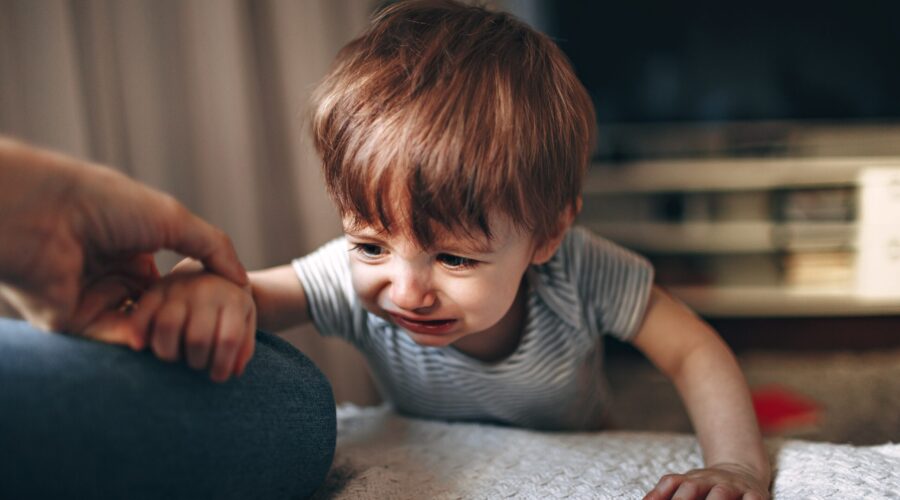6 ways a Therapist can help your Child to deal with Separation Anxiety
 Why my Child is distressed when we are away from them: 6 ways a Therapist can help your child to overcome Separation Anxiety Disorder (SAD).
Why my Child is distressed when we are away from them: 6 ways a Therapist can help your child to overcome Separation Anxiety Disorder (SAD).
Children often start throwing tantrums and get distressed when separated from their parents or caregivers. While it is normal for a child to be slightly intimidated in the absence of their parents, some children face extreme trouble in coping without their parents being around them constantly. It is technically a mental health problem called Separation Anxiety Disorder (SAD).
Separation Anxiety | Symptoms | Self Help | Treatment | Take Away
This disorder is characterized by the child’s fear and constant worry about being away from family or other caregivers.
They are constantly distressed about something happening to the people they love while being away from them. Feeling some sort of anxiety during childhood or teen years is usually a normal part of growing up. This disorder is more common in toddlers. Usually, Separation Anxiety Disorder is a result of a genetic or biological imbalance of neurotransmitters in the brain. It can also result from a traumatic event a child has endured in the past. Children whose parents have an anxiety disorder are more likely to develop separation anxiety themselves.

Here are a few symptoms to look out for.
- Refusing to go to bed alone.
- Nightmares of being away from family.
- Extreme distress when away from family.
- Constant fear of getting lost and separated from family.
- Refusing to go to school or play.
- Always fearful of being left alone.
- Frequent headaches and stomach problems.
- Muscle tension.
- A constant fear of being harmed if left alone.
- Being extremely clingy even while being in the same room.
- Temper tantrums at times of being separated from caregivers.
 In some cases, the symptoms could be a result of momentary physical problems or due to a recent traumatic event. It is important to get a an Expert diagnosis for separation anxiety before concluding anything. A Therapist or a Child Counselor, can successfully diagnose separation anxiety disorder in kids. A physical and mental health evaluation of the child is conducted in a professional environment for an accurate diagnosis. Although you should only be worried if the symptoms last for more than 4 weeks at a time. If this distress or temper tantrums are momentary or due to a certain person or event, there isn’t much to worry about since it could be a result of an environmental factor.
In some cases, the symptoms could be a result of momentary physical problems or due to a recent traumatic event. It is important to get a an Expert diagnosis for separation anxiety before concluding anything. A Therapist or a Child Counselor, can successfully diagnose separation anxiety disorder in kids. A physical and mental health evaluation of the child is conducted in a professional environment for an accurate diagnosis. Although you should only be worried if the symptoms last for more than 4 weeks at a time. If this distress or temper tantrums are momentary or due to a certain person or event, there isn’t much to worry about since it could be a result of an environmental factor.

A Therapist can help diagnose and treat Separation Anxiety using a mix of therapies for the same. It completely depends on the severity of the disorder. If you are child is also facing social problems due to this condition, it is even more important for you to help them get rehabilitated to function normally in society. A combination of therapies like Cognitive Behavior Therapy (CBT) and family therapy can be used in the treatment of Separation Anxiety Disorder. Only a registered mental health practitioner can carry out this process successfully and accurately.
It isn’t much you can do as a parent to prevent Separation Anxiety in your child. However, if you notice any signs of SAD in your child, you should seek a diagnosis as soon as possible. Timely treatment can lessen the impact of the disorder and enhance the child’s development. In some cases, if separation anxiety is left untreated, the child can develop problems with social interaction too. They might not be able to adjust with peers in school, face trouble while interacting with teachers and face difficulty in expressing themselves later on.
Untreated SAD can also result in various mental health problems at later stages. Bedwetting, for example, is a result of the child feeling insecure and anxious. SAD could progress into a Generalized Anxiety Disorder after the child grows up. This could also hamper your relationship with your child because they often develop resentment towards their parents, assuming that the parents don’t care for them and might stop bonding with you at all.
There are some things you can do on an individual level to help your child with separation anxiety disorder.
- Give your child unconditional support and reassurance.
- Help your child in gaining independence while doing basic tasks like going out to play with friends.
- Encourage them to be independent.
- Understand situations that trigger your child. Planning and preparing your child can reduce their distress and make them feel more comfortable even in a new environment.
- Make sure your child’s primary caregivers and teachers know about your child’s condition.
- Seek therapy and rehabilitation for your child from a professional mental health practitioner.
 Here are a few next steps which will help you and your child get the most benefit from visiting a Child Counsellor or a Therapist.
Here are a few next steps which will help you and your child get the most benefit from visiting a Child Counsellor or a Therapist.
- Get a clear understanding of the disorder and know what to expect.
- Take note of the questions and problems you have so that you can seek a solution to them during the session.
- Make sure you write down the key takeaways from the session.
- If your child is being prescribed any medicine for the physical symptoms, find out the side effects of those medicines too.
- Know what to expect from the medicines and the session. Take a clear understanding of the pace of recovery for your child and understand that a proper recovery will take time.
- Make sure you know how to get in touch with the mental health practitioner in case you face an avoidable problem outside of the therapy session.
Key takeaways.
- Separation anxiety disorder is a mental health problem that can be treated. It’s not very difficult if the diagnosis is done on time and therapy is started.
- Expect a few other symptoms of SAD. Social withdrawal, lack of communication, and difficulty in expressing oneself are a few common symptoms of SAD. Eventually, after treatment is done the child will get rehabilitated and significant improvements will be seen.
- The symptoms of SAD should be present for at least four weeks until you seek a diagnosis.
- Only a mental health practitioner, doctor, therapist, counselor, is qualified enough to diagnose and treat SAD.
- Both medicines and therapy are used, usually in combination for the treatment of separation anxiety disorder.
Read more here:
Parental Neglect: Leading To Early Signs Of Depression In Children
Child Anger Management – How to Deal With Your Child’s Anger



